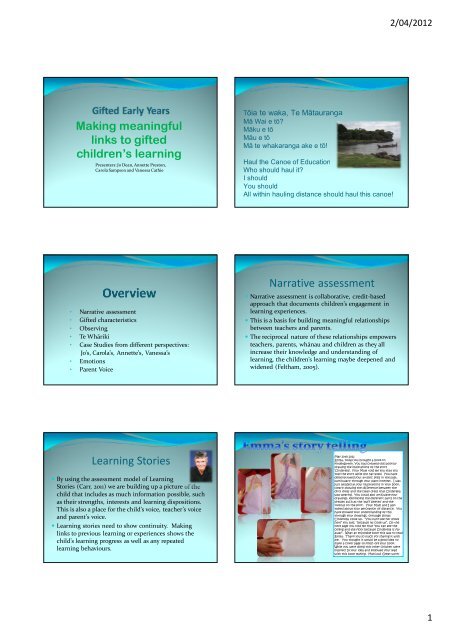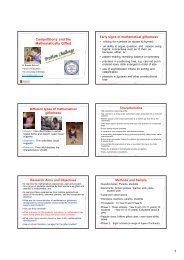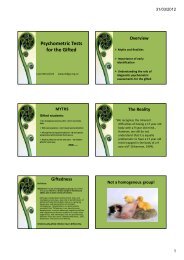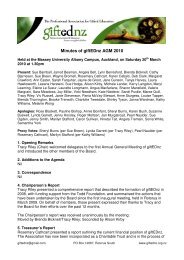Making meaningful links to gifted children's learning - The ...
Making meaningful links to gifted children's learning - The ...
Making meaningful links to gifted children's learning - The ...
You also want an ePaper? Increase the reach of your titles
YUMPU automatically turns print PDFs into web optimized ePapers that Google loves.
2/04/2012<br />
<strong>Making</strong> <strong>meaningful</strong><br />
<strong>links</strong> <strong>to</strong> <strong>gifted</strong><br />
children’s <strong>learning</strong><br />
Presenters: Jo Dean, Annette Pres<strong>to</strong>n,<br />
Carola Sampson and Vanessa Cathie<br />
Tōia te waka, Te Mātauranga<br />
Mā Wai e tō?<br />
Māku e tō<br />
Māu e tō<br />
Mā te whakaranga ake e tō!<br />
Haul the Canoe of Education<br />
Who should haul it?<br />
I should<br />
You should<br />
All within hauling distance should haul this canoe!<br />
• Narrative assessment<br />
• Gifted characteristics<br />
• Observing<br />
• Te Whāriki<br />
• Case Studies from different perspectives:<br />
Jo’s, Carola’s, Annette’s, Vanessa’s<br />
• Emotions<br />
• Parent Voice<br />
Narrative assessment<br />
Narrative assessment is collaborative, credit-based<br />
approach that documents children’s engagement in<br />
<strong>learning</strong> experiences.<br />
This is a basis for building <strong>meaningful</strong> relationships<br />
between teachers and parents.<br />
<strong>The</strong> reciprocal nature of these relationships empowers<br />
teachers, parents, whānau and children as they all<br />
increase their knowledge and understanding of<br />
<strong>learning</strong>, the children’s <strong>learning</strong> maybe deepened and<br />
widened (Feltham, 2005).<br />
Learning S<strong>to</strong>ries<br />
By using the assessment model of Learning<br />
S<strong>to</strong>ries (Carr, 2011) we are building up a picture of the<br />
child that includes as much information possible, such<br />
as their strengths, interests and <strong>learning</strong> dispositions.<br />
This is also a place for the child’s voice, teacher’s voice<br />
and parent’s voice.<br />
Learning s<strong>to</strong>ries need <strong>to</strong> show continuity. <strong>Making</strong><br />
<strong>links</strong> <strong>to</strong> previous <strong>learning</strong> or experiences shows the<br />
child’s <strong>learning</strong> progress as well as any repeated<br />
<strong>learning</strong> behaviours.<br />
May 30th 2011<br />
Emma, <strong>to</strong>day you brought a book <strong>to</strong><br />
kindergarten. You had created this book by<br />
drawing the illustrations of the s<strong>to</strong>ry<br />
‘Cinderella’. Your Mum <strong>to</strong>ld me you that you<br />
<strong>to</strong>ld the s<strong>to</strong>ry while she narrated. You have<br />
demonstrated your artistic skills in the past,<br />
particularly through your plant interest. I was<br />
just amazed at your illustrations in your book,<br />
clearly showing the difference between the<br />
dirty dress and the clean dress that Cinderella<br />
was wearing. You could also articulate your<br />
drawings, identifying the different parts on the<br />
dresses such as the ’puff sleeves’ and the<br />
‘overlay on the skirt’. Your Mum and I also<br />
talked about your perception of distance. You<br />
have showed your understanding of this<br />
through your drawings, one page shows<br />
Cinderella close up. “You can’t see her shoes<br />
here” you said, “because its close up”. On the<br />
next page you <strong>to</strong>ld me that “you can see the<br />
ceiling and the floor because Cinderella is far<br />
away”. What an enjoyable book this was <strong>to</strong> read<br />
Emma. Thank you so much for sharing it with<br />
me. You thought it would be a good idea <strong>to</strong><br />
make a cover page <strong>to</strong> finish off your book.<br />
While you were doing this other children were<br />
inspired by your idea and followed your lead<br />
with this book making. Mahi pai! Great work!<br />
1
2/04/2012<br />
CONTINUITY …..<br />
1st June<br />
Emma, <strong>to</strong>day you brought your friend Mother Bear <strong>to</strong><br />
kindergarten. You had a clear idea on what you wanted <strong>to</strong><br />
do with Mother Bear. You asked if you could use the tape<br />
measure. You had remembered the one in the sewing kit<br />
from the previous week.<br />
Together we went and found the tape measure, you also<br />
thought you might like <strong>to</strong> use some tulle <strong>to</strong> make a “twirly<br />
dress” for Mummy Bear. You got busy measuring Mummy<br />
Bear which worked out <strong>to</strong> be quite long—17 inches. We<br />
talked about making a pattern for Mummy Bear. I was<br />
impressed with the way you thought about that suggestion<br />
Emma. You responded by lying Mummy Bear across my<br />
writing pad and tracing around her body. This will definitely<br />
give us an idea on how big Mummy Bear is. <strong>The</strong>n I suggested<br />
that you draw a plan on what the twirly dress might look<br />
like. Emma, you did a brilliant job of Mummy Bear in a tutu<br />
dress. I can clearly see how you would like the tutu <strong>to</strong> look.<br />
You got busy cutting separate pieces for the “straps, front<br />
bodice and back bodice. This is split down the back”, you<br />
<strong>to</strong>ld me. I was able <strong>to</strong> help you thread the needle so that<br />
you could begin your sewing. I can see you transferring your<br />
creative thinking in<strong>to</strong> lots of different areas of play, Emma.<br />
I can’t wait <strong>to</strong> see the dress on Mummy Bear!<br />
Case study of Emma<br />
Emma’s approach <strong>to</strong> <strong>learning</strong> was through doing,<br />
particularly her sensory experiences.<br />
Emma frequently showed the ability <strong>to</strong> be an<br />
independent problem-solver, using prior knowledge<br />
and experiences <strong>to</strong> deepen her understanding. Emma<br />
expressed a high concentration span.<br />
Rich vocabulary base of over 200 words at the age of<br />
two.<br />
Very good memory and could quickly recall s<strong>to</strong>ries &<br />
songs heard some time ago.<br />
Gifted Characteristics<br />
Curiosity<br />
<strong>The</strong> ability <strong>to</strong> learn quickly from mistakes<br />
<strong>The</strong> ability <strong>to</strong> transfer knowledge<br />
Depth and breadth of interest.<br />
Advanced preference in books and videos.<br />
Boredom when forced in<strong>to</strong> redundant work and <strong>learning</strong>.<br />
Decrease in quality on a series of repetitive tasks.<br />
Creative mischief<br />
Friends<br />
Games (Porter, 2005; Mare, 1991)<br />
Observing<br />
Allow the child the opportunities <strong>to</strong> explore possibilities<br />
at his or her natural pace and be prepared for changes in<br />
interest and commitment as each child continues <strong>to</strong><br />
move through changes.<br />
If the child keeps options open, the future will remain<br />
flexible and rewarding.<br />
Unless you work with the child your message <strong>to</strong> her/him<br />
is that you do not approve of or accept as s/he actually is.<br />
(Porter, L, 1995)<br />
Carola Sampson<br />
“Dereck”<br />
Noticing, recognising and responding<br />
Do you see all of the above?<br />
Noticing, recognising and responding<br />
2
2/04/2012<br />
Māori <strong>gifted</strong>ness as broad wide ranging<br />
concept with various areas like -<br />
spiritual, cognitive, affective, aesthetic,<br />
artistic, musical, psychomo<strong>to</strong>r, social,<br />
intuitive, creative, leadership, cultural<br />
abilities and qualities.<br />
Below another one of the many tables/checklist for<br />
identification, however this one contains indica<strong>to</strong>rs related<br />
<strong>to</strong> Māori <strong>gifted</strong>ness and is neither complete nor does it apply <strong>to</strong><br />
every situation and/or <strong>to</strong> every child. But it still helps teachers <strong>to</strong><br />
get the “idea” what <strong>to</strong> look for, what <strong>to</strong> recognise. Bevan-Brown<br />
warns that a child outstanding in te reo in mainstream class, might<br />
not be as outstanding compared <strong>to</strong> Māori kura kaupapa students.<br />
(Bevan-Brown, 1993; 2009)<br />
Dereck has chosen his culturally<br />
preferred way of <strong>learning</strong>, which is<br />
valued and supported by his teachers.<br />
He is “in charge” of his <strong>learning</strong><br />
through his interests and teachers can<br />
follow his lead in “where <strong>to</strong> next”. He<br />
involves peers, teachers, family and<br />
community.<br />
Bevan-Brown, J.M. (2009). Identifying and providing for <strong>gifted</strong> and<br />
talented Mäori students. APEX,<br />
15(4), 6-20. Retrieved online from<br />
http://www.<strong>gifted</strong>children.org.nz/apex/<br />
Linking Te Whāriki in<strong>to</strong><br />
<strong>learning</strong> s<strong>to</strong>ries, bringing<br />
it <strong>to</strong> life - Kei Tua o te Pae<br />
Early childhood curriculum: Te Whāriki<br />
Te Whāriki places emphasis on planning based on individual characteristic strength,<br />
interests and needs. All children have the right “<strong>to</strong> reach their potential”.<br />
Teachers can provide for <strong>gifted</strong> children by identifying the areas of individual<br />
<strong>gifted</strong>ness and respond in developmentally appropriate ways (Allan, 2000).<br />
“Planning experiences or events can focus on the environment, the setting, particular<br />
age groups, and on groups of children or individual children through an IDP or IEP”<br />
(Ministry of Education, 1996, p. 28).<br />
8 ½ months<br />
16 months<br />
Principles<br />
Whakamana - Empowerment<br />
Kotahitanga - Holistic development<br />
Whānau Tangata - Family and Community<br />
Ngā Hononga - Relationships<br />
4/8/10 3 years 2 months<br />
Jackson is often interested in one particular creature<br />
at a time, carrying the model around with him.<br />
Parasaurolophus is the dinosaur Jackson has<br />
attached <strong>to</strong> lately and he asked me if we could find<br />
one on the lap<strong>to</strong>p. He matched the model <strong>to</strong> the<br />
dinosaur poster and looked at the word on the chart<br />
<strong>to</strong> type in his search. We discussed the features of<br />
parasaurolophus looking out for the large horn on its<br />
head. Jackson is developing his literacy skills as he<br />
recognises letters on the keyboard. He is able <strong>to</strong><br />
seek out resources and make connections in his<br />
understanding as he researches his interests.<br />
Emma<br />
3 years 6 months<br />
Emotions<br />
Emma<br />
Intensified:<br />
experiences<br />
emotions<br />
feelings<br />
perceptions<br />
imaginations<br />
Gives the ability <strong>to</strong> grow <strong>to</strong> their fullest potential<br />
However, with inner growth there is also constant<br />
questioning of values and beliefs (Daniels & Piechowski,<br />
2009)<br />
3
2/04/2012<br />
Parent Voice<br />
Linking home and early childhood setting<br />
Empowering <strong>to</strong> increase understanding of own child<br />
Opportunities <strong>to</strong> share and deepening understanding<br />
of child.<br />
Provide support and encouragement<br />
Respect parents perspective.<br />
<br />
“That’s ‘M’ for my mama!”<br />
One morning Scarlett found that someone had<br />
written on the paper “Hi mummy” and “Sophia”. When<br />
she saw it, her big, bright eyes lit up and she said<br />
loudly<br />
“That’s ‘S’ for Scarlett, ‘M’ for mama and ‘H’<br />
for Harry”<br />
I was amazed <strong>to</strong> see that Scarlett is able <strong>to</strong> recognise<br />
some letters of the alphabet. <strong>The</strong>n, I <strong>to</strong>ld her what it<br />
said on the paper and she asked me <strong>to</strong> write her name,<br />
‘my mama’ and ‘Harry’. After that, she spent some<br />
time looking at the words and trying <strong>to</strong> copy them.<br />
Age: 2 years 8 months<br />
Open-mindedness & Opportunities<br />
Provide opportunities for individual children based on<br />
needs and desires and irrespective of what is “normal”.<br />
Traits might include:<br />
Curiosity<br />
Early interest in letters and words<br />
Early ability <strong>to</strong> read (Scarlett read first book at 2.11<br />
years)<br />
Rapid pace of <strong>learning</strong><br />
Advanced play behaviour<br />
Intensity of purpose and task commitment<br />
Implications<br />
Depth, intensity and quality of <strong>learning</strong> requires varied<br />
and interesting experiences.<br />
Open-ended play experiences<br />
Au<strong>to</strong>nomous <strong>learning</strong><br />
Creative resources<br />
Activities for discovery and investigation<br />
Strategies for problem-solving<br />
Opportunities <strong>to</strong> learn how <strong>to</strong> access reference<br />
resources<br />
(Harrison, 2003)<br />
Early School Years<br />
Issues associated with heightened sensitivities, social<br />
interaction and mature interests that emerge for<br />
children during the prior-<strong>to</strong>-school period were<br />
accentuated with this more formal and often less<br />
flexible and supportive educational setting.<br />
4
2/04/2012<br />
A different way of thinking<br />
A s<strong>to</strong>ry for Harry by Vanessa<br />
June 2010 (Age 5:1)<br />
Harry, <strong>to</strong>day I had a meeting with your teacher about your reading because you<br />
are reading so beautifully at home <strong>to</strong> me. I wanted <strong>to</strong> make sure that she gave<br />
you books that were hard enough for you because I know that you don’t like<br />
reading books that are <strong>to</strong>o easy. I know that sometimes you pretend that you<br />
can’t read the easy books!<br />
<strong>The</strong> teacher <strong>to</strong>ld me that she asked you <strong>to</strong> read her a s<strong>to</strong>ry – it was about a boy<br />
called John.<br />
After the s<strong>to</strong>ry she asked you some questions which you answered using your<br />
fabulous creative brain! One of the questions she asked you was “What was<br />
John wearing?” <strong>The</strong> teacher <strong>to</strong>ld me that you said that John was wearing “a big<br />
smile”. What a great answer, Harry! John was a happy boy and you had<br />
unders<strong>to</strong>od that!<br />
Sadly, the teacher <strong>to</strong>ld you that your answer was wrong because she meant that<br />
John was wearing “a blue shirt” but do you know what, Harry? I think your<br />
answer was very clever! You unders<strong>to</strong>od that people can wear smiles as well as<br />
clothes! What a clever observation! Your answer wasn’t wrong at all!<br />
I think that was a great lesson for you, Harry. You have learnt that there may<br />
be more than one right answer <strong>to</strong> questions! Also, you understand that even<br />
teachers make mistakes sometimes and that is ok <strong>to</strong>o.<br />
Bravo, Harry!<br />
A call for greater flexibility<br />
Transition <strong>to</strong> school – meetings/forms/open dialogue free<br />
of judgment.<br />
Respond <strong>to</strong> <strong>learning</strong> strengths.<br />
Match educational experiences <strong>to</strong> stage of development<br />
(not “lock-step”).<br />
Appreciate parents’ responses. Parents’ push for<br />
appropriate educational provisions does not equate <strong>to</strong><br />
“pushy” parents.<br />
Reluctance <strong>to</strong> discuss.<br />
Open dialogue based on understanding and sensitivity<br />
versus “you really need <strong>to</strong> let him just be a child”.<br />
Awareness of range of educational<br />
options<br />
Enrichment versus “more of the same”<br />
a. Content (what is learned)<br />
b. Process (teaching methods uses)<br />
c. Learning environment (physical and psychological)<br />
d. Products produced<br />
Early entry<br />
Acceleration<br />
Special grouping<br />
Guidance or counselling<br />
(Harrison, 2003)<br />
Pedagogy<br />
Recognising each child as complex, capable, curious<br />
and intensely motivated in pursuing their search for<br />
complexity and connection.<br />
Recognising that parents and families are experts who<br />
have extensive and significant knowledge and<br />
experience <strong>to</strong> contribute <strong>to</strong> the education and care of<br />
the young child.<br />
(Porter, L. 2005)<br />
Support for Gifted Children<br />
Observant teachers and parents/whānau<br />
Provide resources <strong>to</strong> support<br />
Develop shared understanding<br />
Encourage<br />
Holistic view of child in developing understanding<br />
Minimise barriers<br />
Teacher advocate for/of parents/child<br />
Ways <strong>to</strong> help for Parents and<br />
Teachers<br />
Support<br />
Encourage<br />
Advocate<br />
Minimise barriers<br />
5
2/04/2012<br />
Acknowledgements<br />
We sincerely thank all our wonderful children, families<br />
and colleagues in allowing us <strong>to</strong> share their work.<br />
We couldn’t have done this without the wonderful<br />
support.<br />
References<br />
Bevan-Brown, J.M. (2009). Identifying and providing for <strong>gifted</strong> and talented Māori students.<br />
APEX, 15(4), 6-20. Retrieved online from http://www.<strong>gifted</strong>children.org.nz/apex/<br />
Carr, M. (2001). Assessment in early childhood settings: Learning s<strong>to</strong>ries. London: Sage Publications Ltd.<br />
Daniels, S. & Meckstroth, E. (2009). Nurturing the sensitivity, insensitivity, and developmental potential<br />
of <strong>gifted</strong> young children. In S. Daniels & M. Piechowski (Eds) Living with intensity ( pp. 33- 56).<br />
Scottsdale, AZ: Great Potential Press.<br />
Feltham, S. (2005, February 7). Setting a positive example. New Zealand Education Gazette, pp. 10 -12.<br />
Harrison, C. (2003). Giftedness in early childhood (3 rd ed.). Gerric, <strong>The</strong> University of NSW, Sydney.<br />
Mares, L. (1991). Young <strong>gifted</strong> children.Cheltenham, Australia: Hawker Brownlow.<br />
Ministry of Education. (2004). Kei tua o te pae: Assessment for <strong>learning</strong>. Early childhood exemplars.<br />
Welling<strong>to</strong>n, New Zealand: Learning Media.<br />
Ministry of Education. (1996). Te Whāriki – He whāriki mātauranga mō ngā mokopuna o Aotearoa. Early<br />
childhood curriculum. Ministry of Education. Welling<strong>to</strong>n, New Zealand: Learning Media.<br />
Piechowski, M (2006). “Mellow out” they say. If I only could. Intensities and sensitivities of the young and<br />
bright. USA, Wisconsin: Yunasa Books.<br />
Porter, L. (2005). Young <strong>gifted</strong> children: Meeting their needs. Early Childhood Australia, Inc. Australia.<br />
Canberra.<br />
6






![Sara Meadows.ppt [Compatibility Mode] - The Professional ...](https://img.yumpu.com/21469333/1/184x260/sara-meadowsppt-compatibility-mode-the-professional-.jpg?quality=85)


